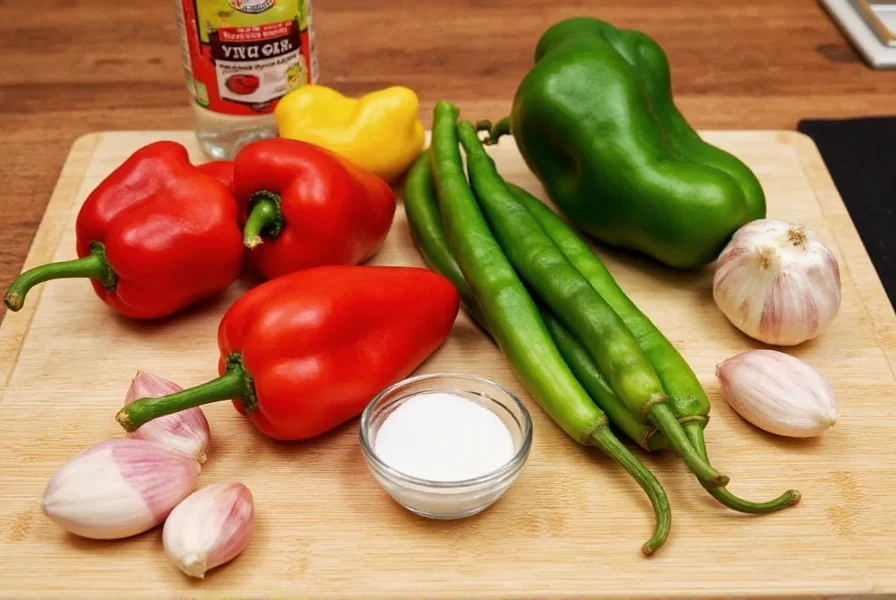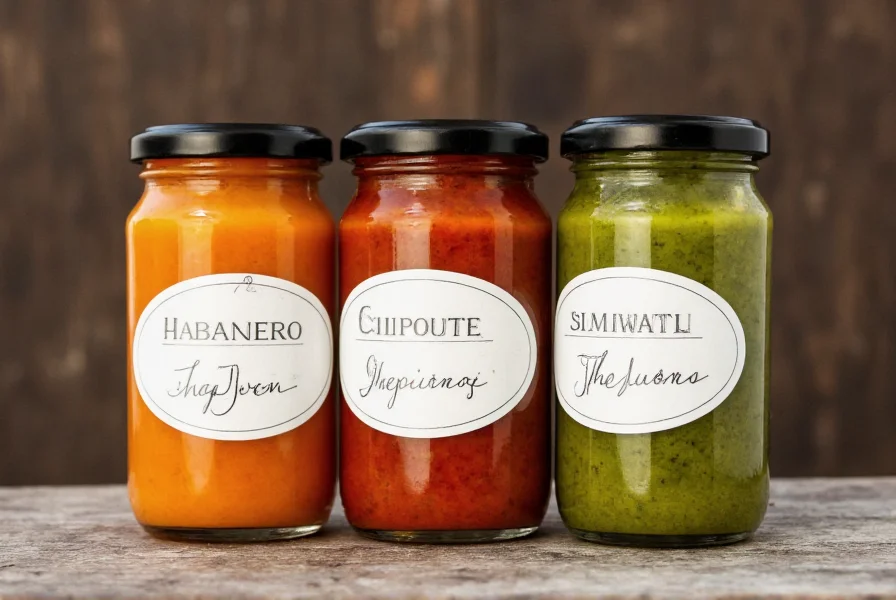Making your own pepper sauce at home gives you complete control over ingredients, heat level, and flavor profile. Unlike store-bought versions that often contain preservatives and artificial ingredients, homemade pepper sauce delivers vibrant, fresh flavor that elevates any dish. Whether you prefer mild bell peppers or fiery habaneros, this customizable recipe accommodates your taste preferences while requiring minimal equipment and preparation time.
Essential Ingredients for Perfect Pepper Sauce
The beauty of homemade pepper sauce lies in its simplicity. You only need a few quality ingredients to create a professional-quality condiment:
- Peppers: 1 pound fresh peppers (jalapeños for medium heat, habaneros for extreme heat, or mixed varieties for complexity)
- Vinegar: 1/2 cup distilled white vinegar or apple cider vinegar for tang and preservation
- Garlic: 2-3 cloves, peeled
- Salt: 1 teaspoon fine sea salt
- Sugar: 1/4 teaspoon (optional, balances acidity)
- Water: As needed for desired consistency

Equipment You'll Need
Specialized equipment isn't necessary for this straightforward recipe:
- Blender or food processor
- Baking sheet (for roasting peppers)
- Small saucepan
- Sterilized glass jars with lids
- Fine mesh strainer (optional, for smoother texture)
- Heatproof gloves (when handling hot peppers)
Step-by-Step Preparation Guide
1. Prepare the Peppers
Wear gloves when handling hot peppers to avoid skin irritation. Remove stems and roughly chop peppers, keeping seeds for extra heat or removing them for milder sauce. For deeper flavor, roast peppers by placing them on a baking sheet under the broiler for 5-7 minutes until charred, then seal in a bowl covered with plastic wrap for 15 minutes to steam.
2. Blend Ingredients
Combine roasted or raw peppers, vinegar, garlic, salt, and sugar in a blender. Process until completely smooth, about 2-3 minutes. Add water sparingly (1 tablespoon at a time) if needed to facilitate blending.
3. Simmer the Sauce
Pour the blended mixture into a saucepan and bring to a gentle simmer over medium heat. Cook for 8-10 minutes, stirring occasionally. This step enhances flavor and ensures proper preservation. The sauce will thicken slightly as it cooks.
4. Strain (Optional)
For a smoother texture, strain the sauce through a fine mesh sieve, pressing with a spoon to extract maximum liquid. This step removes fibrous pepper bits while retaining all flavor.
5. Bottle and Store
Pour the hot sauce into sterilized glass jars, leaving 1/4 inch headspace. Seal tightly and let cool to room temperature before refrigerating. Properly stored, homemade pepper sauce maintains quality for 3-4 weeks in the refrigerator.
| Pepper Type | Heat Level (Scoville) | Flavor Profile | Recommended Use |
|---|---|---|---|
| Jalapeño | 2,500-8,000 | Grassy, bright | Everyday sauce, salsas |
| Serrano | 10,000-23,000 | Sharp, herbal | Mexican cuisine, marinades |
| Habanero | 100,000-350,000 | Fruity, floral | Caribbean dishes, hot sauces |
| Ghost Pepper | 855,000-1,041,427 | Smoky, sweet | Extreme heat challenges |
Popular Pepper Sauce Variations
Once you've mastered the basic technique, experiment with these delicious variations:
- Tropical Habanero: Add 1/2 cup mango or pineapple and 1 tablespoon lime juice for a sweet-spicy Caribbean-style sauce
- Smoky Chipotle: Use 4-5 canned chipotle peppers in adobo sauce instead of fresh peppers for deep smoky flavor
- Garlic Lover's: Double the garlic and add 1 teaspoon dried oregano for an Italian-inspired version
- Green Pepper Sauce: Use tomatillos, serranos, and jalapeños for a vibrant green sauce perfect for huevos rancheros

Storage and Shelf Life Tips
Proper storage ensures your homemade pepper sauce maintains both safety and quality:
- Always use sterilized containers to prevent bacterial growth
- Refrigerate immediately after cooling and use within 3-4 weeks
- For longer storage, freeze in ice cube trays then transfer to freezer bags (keeps 6 months)
- Signs of spoilage include mold, off smells, or bubbling in the container
- Acidic ingredients like vinegar help preservation but don't eliminate refrigeration needs
Troubleshooting Common Issues
Even experienced sauce makers encounter these common challenges:
- Too spicy: Balance with additional vinegar, a touch of honey, or dairy like yogurt
- Too thin: Simmer longer to reduce or add a small amount of xanthan gum (1/8 teaspoon)
- Bitter taste: Over-roasted peppers cause bitterness; add 1/4 teaspoon sugar to counteract
- Separation: Shake well before use or add 1/2 teaspoon guar gum while blending
- Weak flavor: Use fully ripe peppers and ensure proper simmering time to develop flavors
Culinary Applications for Homemade Pepper Sauce
Move beyond basic hot sauce usage with these creative applications:
- Whisk into mayonnaise for spicy sandwich spread
- Add to bloody mary mix for homemade cocktail
- Stir into soups and stews during final minutes of cooking
- Marinate proteins before grilling or roasting
- Drizzle over avocado toast or eggs for breakfast
- Mix with melted butter for spicy lobster or corn dip
Frequently Asked Questions
How can I reduce the heat level in homemade pepper sauce?
To reduce heat, remove all seeds and white membranes from peppers before processing, as these contain most capsaicin. You can also balance intense heat by adding sweet elements like roasted carrots, mango, or a small amount of honey. Diluting with additional vinegar or water also decreases spiciness while maintaining flavor.
Why does my homemade pepper sauce separate?
Separation occurs because oil from peppers rises to the top while vinegar-based liquid settles below. This is normal and doesn't indicate spoilage. Simply shake well before each use. For more stable emulsions, blend longer to break down fibers completely or add a small amount (1/8 teaspoon) of xanthan gum during blending.
Can I use dried peppers instead of fresh for pepper sauce?
Yes, dried peppers work well but require rehydration first. Soak 1 ounce of dried peppers in 2 cups of hot water for 30-60 minutes until soft. Drain, reserving 1/2 cup soaking liquid, then blend with other ingredients using the reserved liquid instead of water. Dried peppers often provide more concentrated, complex flavors than fresh varieties.
How long should I let pepper sauce ferment for better flavor?
For fermented pepper sauce, combine chopped peppers with 2-3% salt by weight and submerge in brine. Ferment at room temperature for 1-3 weeks, burping the container daily. Longer fermentation (up to 3 months) develops deeper, more complex flavors. After fermentation, blend with vinegar and simmer briefly before bottling. Fermentation enhances both flavor complexity and natural preservation.
What's the best way to preserve homemade pepper sauce for long-term storage?
For long-term preservation beyond refrigeration, process filled jars in a boiling water bath for 15 minutes to create a vacuum seal. This canning method allows shelf-stable storage for up to one year in a cool, dark place. Alternatively, freeze sauce in ice cube trays then transfer cubes to freezer bags for portioned use. Always refrigerate after opening, even if previously canned.











 浙公网安备
33010002000092号
浙公网安备
33010002000092号 浙B2-20120091-4
浙B2-20120091-4